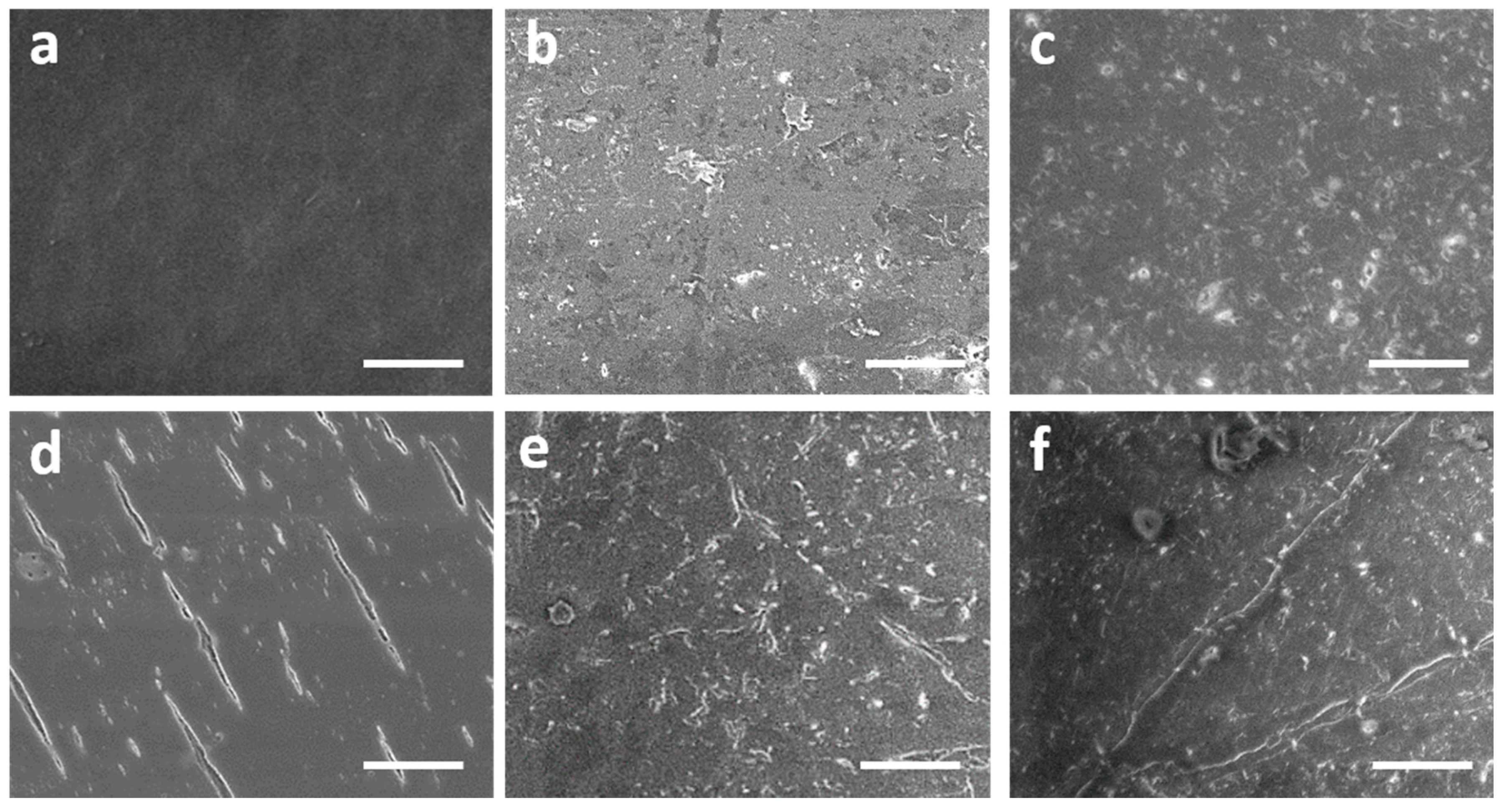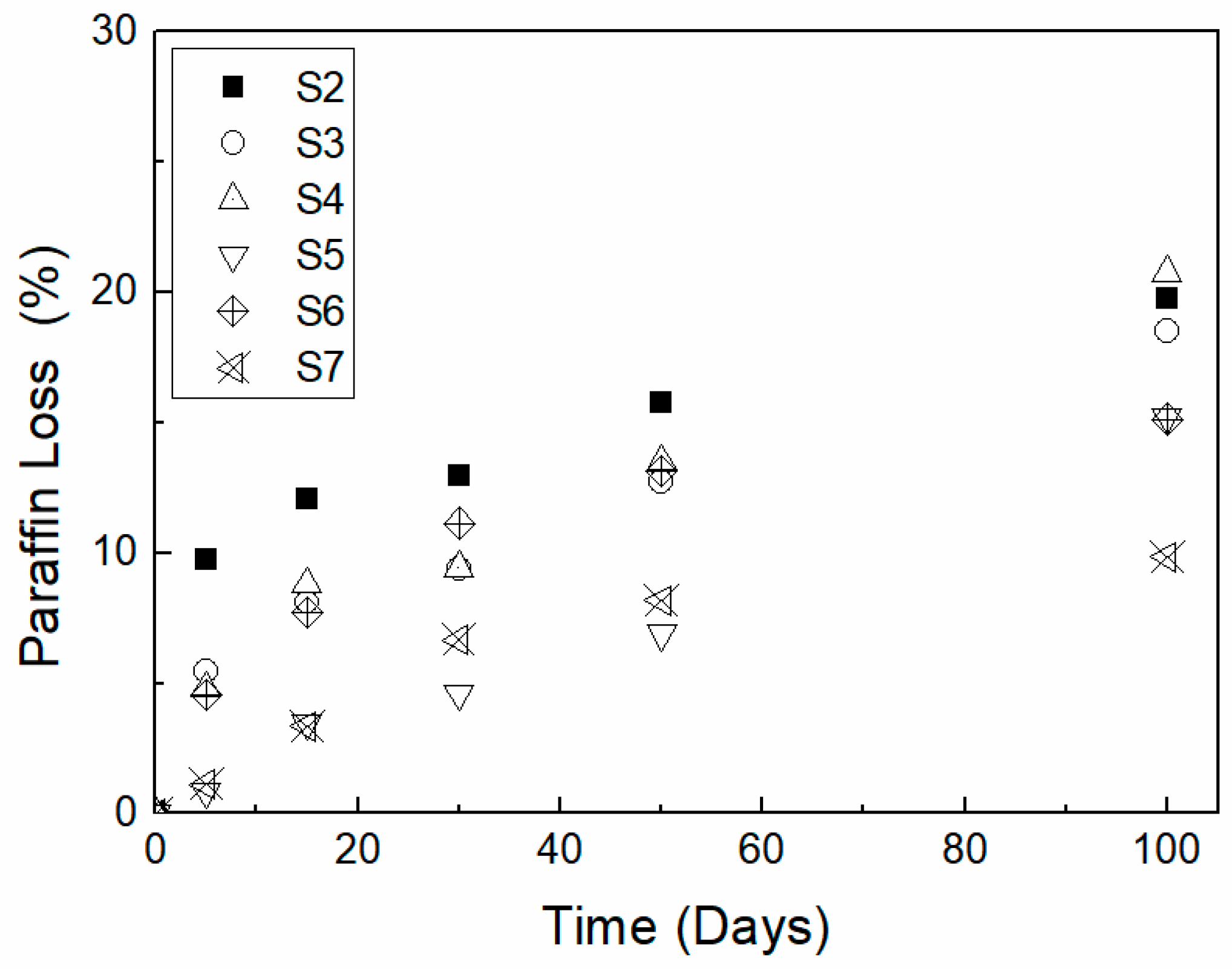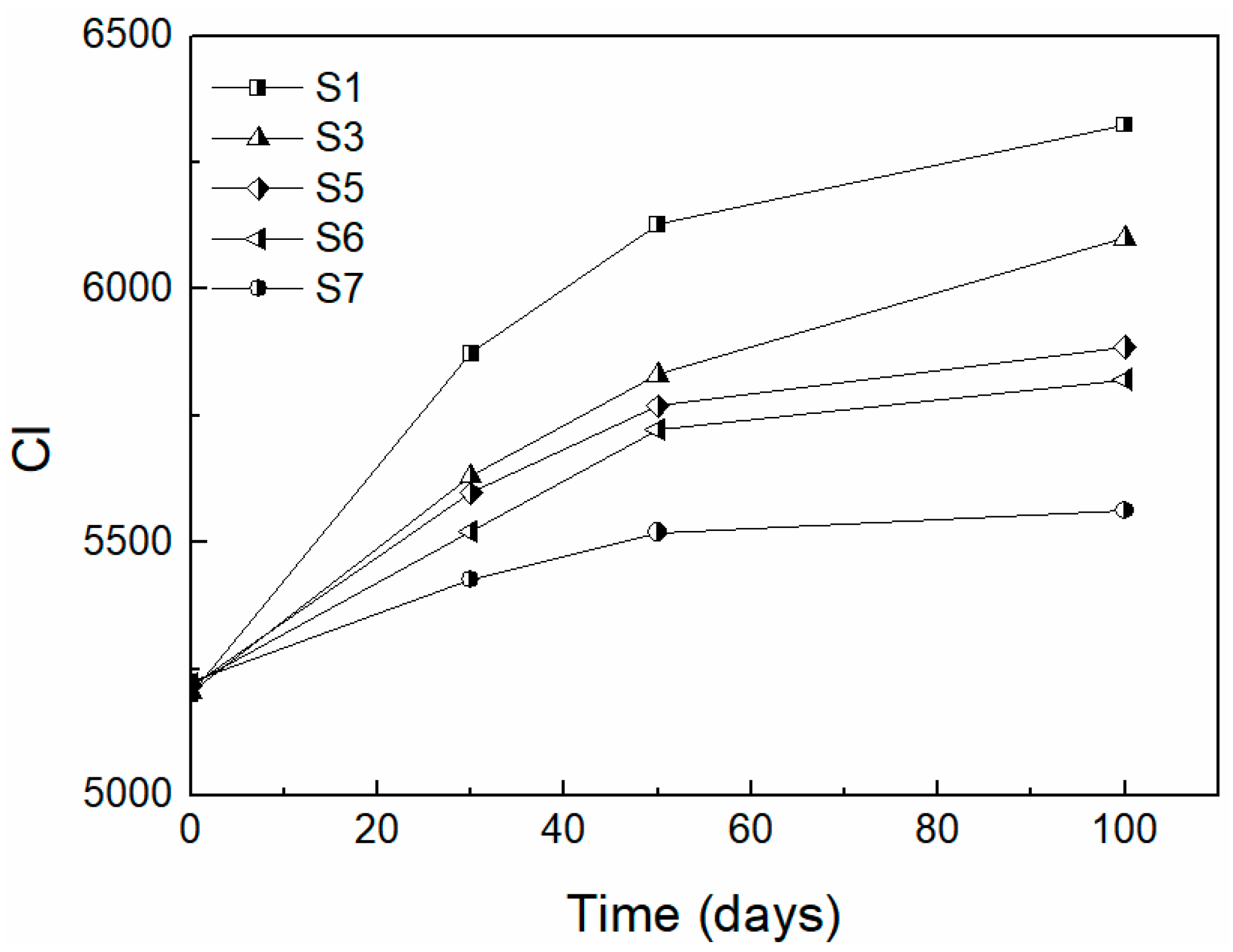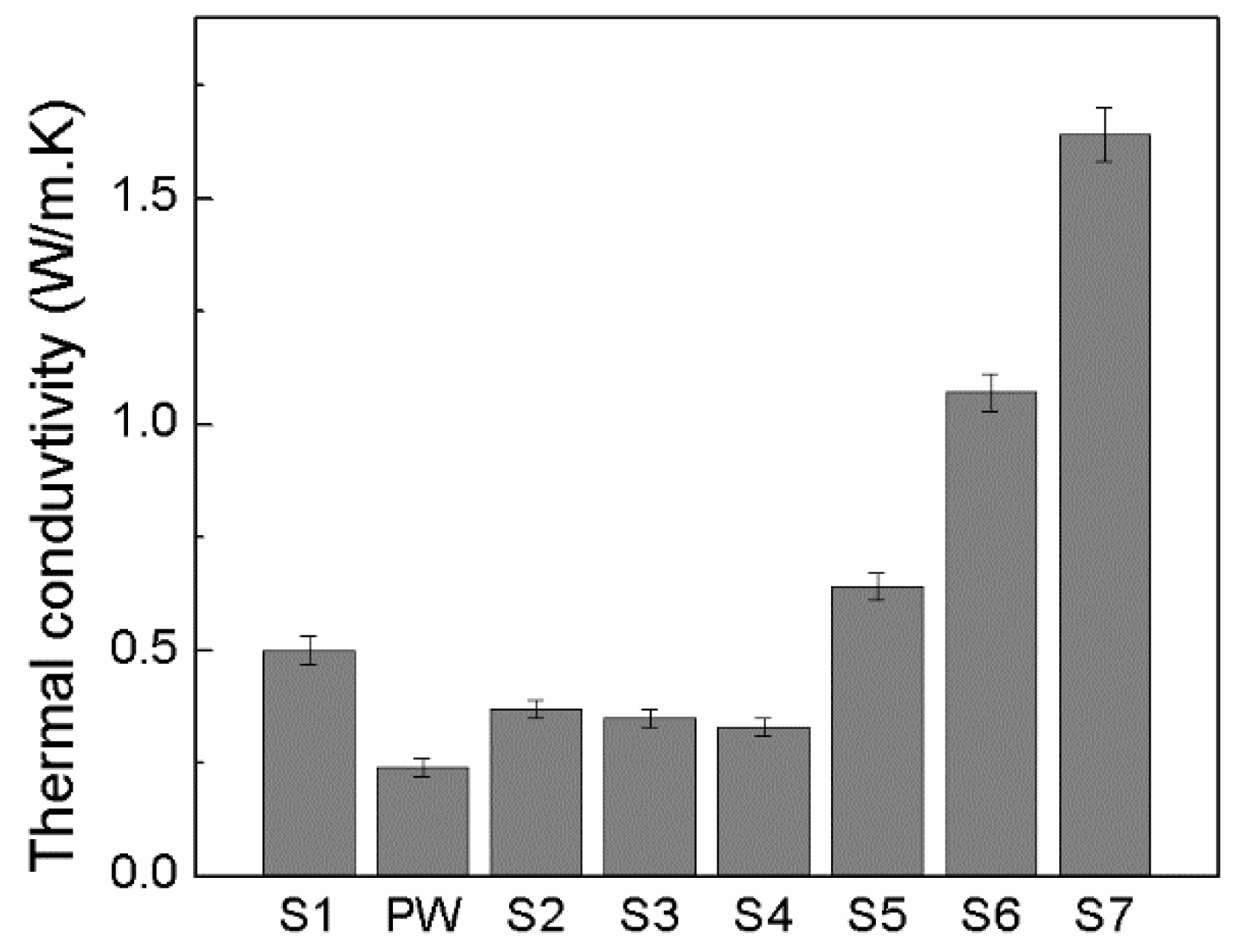Recycled Polyethylene/Paraffin Wax/Expanded Graphite Based Heat Absorbers for Thermal Energy Storage: An Artificial Aging Study
Abstract
1. Introduction
2. Results and Discussion
2.1. Morphology
2.2. Leakage Analysis
2.3. FTIR Analysis
2.4. Thermal Investigation
2.4.1. Thermal Conductivity
2.4.2. Differential Scanning Calorimetry (DSC)
2.5. Mechanical Properties of PCMs
3. Materials and Methods
3.1. Materials
3.2. Sample Preparation
3.3. Characterizations
4. Conclusions
Author Contributions
Funding
Conflicts of Interest
Abbreviations
| CI | carbonyl index |
| DSC | Differential Scanning Calorimetry |
| FTIR | Fourier-transform infrared spectroscopy |
| HDPE | high-density polyethylene |
| E | Young’s modulus |
| EG | expanded graphite |
| m0 | initial mass of a specimen |
| mx | actual mass of a specimen |
| keV | kilo electron volt |
| PCMs | phase change materials |
| PE | polyethylene |
| PP | polypropylene |
| PS | polystyrene |
| PW | paraffin wax |
| SEM | Scanning Electron Microscopy |
| SD | standard deviation |
| Tm | melting temperature |
| TPS | transient plane source |
| UV | ultraviolet |
| w | mass fraction of paraffin wax |
| W | watt |
| wt% | weight percentage |
| ΔHm | enthalpy of melting |
| σ | stress at break and |
| ε | elongation at break |
References
- World Business Council for Sustainable Development. Roadmap for a Transformation of Energy Use in Buildings; World Business Council for Sustainable Development: Geneva, Switzerland, 2009; Available online: https://www.wbcsd.org/Programs/Cities-and-Mobility/Energy-Efficiency-in-Buildings/Resources/Roadmap-for-a-Transformation-of-Energy-Use-in-Buildings (accessed on 30 August 2009).
- Nazir, H.; Batool, M.; Osorio, F.J.B.; Isaza-Ruiz, M.; Xu, X.; Vignarooban, K.; Phelan, P.; Kannan, A.M. Recent developments in phase change materials for energy storage applications: A review. Int. J. Heat. Mass Transf. 2019, 129, 491–523. [Google Scholar] [CrossRef]
- Khudhair, A.M.; Farid, M.M. A review on energy conservation in building applications with thermal storage by latent heat using phase change materials. Energy Convers. Manag. 2004, 45, 263–275. [Google Scholar] [CrossRef]
- Umair, M.M.; Zhang, Y.; Iqbal, K.; Zhang, S.; Tang, B. Novel strategies and supporting materials applied to shape-stabilize organic phase change materials for thermal energy storage—A review. Appl. Energy 2019, 235, 846–873. [Google Scholar] [CrossRef]
- Hasnain, S.M. Review on sustainable thermal energy storage technologies, Part I: Heat storage materials and techniques. Energy Convers. Manag. 1998, 39, 1127–1138. [Google Scholar] [CrossRef]
- Tumirah, K.; Hussein, M.Z.; Zulkarnain, Z.; Rafeadah, R. Nano-encapsulated organic phase change material based on copolymer nanocomposites for thermal energy storage. Energy 2014, 66, 881–890. [Google Scholar] [CrossRef]
- Sarı, A.; Alkan, C.; Bilgin, C. Micro/nano encapsulation of some paraffin eutectic mixtures with poly(methyl methacrylate) shell: Preparation, characterization and latent heat thermal energy storage properties. Appl. Energy 2014, 136, 217–227. [Google Scholar] [CrossRef]
- Serrano, A.; Borreguero, A.M.; Garrido, I.; Rodríguez, J.F.; Carmon, M. Reducing heat loss through the building envelope by using polyurethane foams containing thermoregulating microcapsules. Appl. Therm. Eng. 2016, 103, 226–232. [Google Scholar] [CrossRef]
- Krupa, I.; Luyt, A.S. Thermal properties of uncross-linked and cross-linked LLDPE/wax blends. Polym. Degrad. Stabil. 2000, 70, 111–117. [Google Scholar] [CrossRef]
- Krupa, I.; Luyt, A.S. Mechanical properties of uncross-linked and cross-linked LLDPE/wax blends. J. Appl. Polym. Sci. 2001, 81, 973–980. [Google Scholar] [CrossRef]
- Luyt, A.S.; Krupa, I. PE/wax blends: Interesting observations. Macromol. Symp. 2002, 178, 109–116. [Google Scholar] [CrossRef]
- Chen, F.; Wolcott, M. Polyethylene/paraffin binary composites for phase change material energy storage in building: A morphology, thermal properties, and paraffin leakage study. Sol. Energy Mater. Sol. Cells 2015, 137, 79–85. [Google Scholar] [CrossRef]
- Chen, P.; Gao, X.; Wang, Y.; Xu, T.; Fang, Y.; Zhang, Z. Metal foam embedded in SEBS/paraffin/HDPE form-stable PCMs for thermal energy storage. Sol. Energy Mater. Sol. Cells 2016, 149, 60–65. [Google Scholar] [CrossRef]
- Sobolciak, P.; Karkri, M.; Al-Maadeed, M.A.; Krupa, I. Thermal characterization of phase change materials based on linear low-density polyethylene, paraffin wax and expanded graphite. Renew. Energy 2016, 88, 372–382. [Google Scholar] [CrossRef]
- Chen, F.; Wolcott, M.P. Miscibility studies of paraffin/polyethylene blends as form-stable phase change materials. Eur. Polym. J. 2014, 52, 44–52. [Google Scholar] [CrossRef]
- Bantrup, J.; Immergut, E.; Grulke, E. Polymer Handbook, 4th ed.; John Wiley & Sons, Inc.: New York, NY, USA, 1999. [Google Scholar]
- Sari, A.; Karaipekli, A. Thermal conductivity and latent heat thermal energy storage characteristics of paraffin/expanded graphite composite as phase change material. Appl. Therm. Eng. 2007, 27, 1271–1277. [Google Scholar] [CrossRef]
- Behzadi, S.; Farid, M.M. Long term thermal stability of organic PCMs. Appl. Energy 2014, 122, 11–16. [Google Scholar] [CrossRef]
- Fauzi, H.; Metselaar, S.C.; Mahlia, T.M.I.; Silakhori, M. Thermo-physical stability of fatty acid eutectic mixtures subjected to accelerated aging for thermal energy storage (TES) application. Appl. Therm. Eng. 2014, 66, 328–334. [Google Scholar] [CrossRef]
- Sharma, R.K.; Ganesan, P.; Tyagi, V.V.; Mahlia, T.M.I. Accelerated thermal cycle and chemical stability testing of polyethylene glycol (PEG) 6000 for solar thermal energy storage. Sol. Energy Mater. Sol. Cells 2016, 147, 235–239. [Google Scholar] [CrossRef]
- Al-Qaradawi, I.Y.; Abdulmalik, D.A.; Madi, N.K.; Almaadeed, M.A. Gamma irradiation effects on polymethyl methacrylate. Phys. Status Solidi C 2007, 4, 3727–3730. [Google Scholar] [CrossRef]
- AlMaadeed, M.A. Change in structure of ultrahigh molecular weight polyethylene due to irradiation in air and in nitrogen. Int. J. Polym. Anal. Charact. 2005, 11, 71–84. [Google Scholar] [CrossRef]
- Al-Maadeed, M.A.; Labidi, S.; Krupa, I.; Karkri, M. Effect of expanded graphite on the phase change materials of high density polyethylene/wax blends. Thermochim. Acta 2015, 600, 35–44. [Google Scholar] [CrossRef]
- Sobolciak, P.; Mrlik, M.; AlMaadeed, M.A.; Krupa, I. Calorimetric and dynamic mechanical behavior of phase change materials based on paraffin wax supported by expanded graphite. Thermochim. Acta 2015, 617, 111–119. [Google Scholar] [CrossRef]
- Allen, N.S.; Adge, M.; Houldsworth, D.; Rahman, A.; Catalina, F.; Fontan, E. Ageing and spectroscopic properties of polyethylenes: Comparison with metallocene polymer. Polym. Degrad. Stabil. 2000, 67, 57–67. [Google Scholar] [CrossRef]
- Roy, P.K.; Surekha, P.; Rajagopal, C.; Choudhary, V. Degradation behavior of linear low-density polyethylene films containing prooxidants under accelerated test conditions. J. Appl. Polym. Sci. 2008, 108, 2726–2733. [Google Scholar] [CrossRef]
- Bigger, S.W.; Delatycki, O. The effects of pigments on the photostability of polyethylene. J. Mater. Sci. 1989, 24, 1946–1952. [Google Scholar] [CrossRef]
- Sobolčiak, P.; Abdelrazeq, H.; Ouederni, M.; Karkri, M.; Al-Maadeed, M.; Krupa, I. The stabilizing effect of expanded graphite on the artificial aging of shape stabilized phase change materials. Polym. Test. 2015, 46, 65–71. [Google Scholar] [CrossRef]
- Ling, Z.; Chen, J.; Xu, T.; Fang, X.; Gao, X.; Zhang, Z. Thermal conductivity of an organic phase change material/expanded graphite composite across the phase change temperature range and a novel thermal conductivity model. Energy Convers. Manag. 2015, 102, 202–208. [Google Scholar] [CrossRef]
- Dikobe, D.G.; Luyt, A.S. Thermal and mechanical properties of PP/HDPE/wood powder and MAPP/ HDPE/wood powder polymer blend composites. Thermochim. Acta 2017, 654, 40–50. [Google Scholar] [CrossRef]
- Sotomayor, M.E.; Krupa, I.; Várez, A.; Levenfeld, B. Thermal and mechanical characterization of injection moulded high density polyethylene/paraffin wax blends as phase change materials. Renew. Energy 2014, 68, 140–145. [Google Scholar] [CrossRef]
- Krupa, I.; Chodak, I. Physical properties of thermoplastic/graphite composites. Eur. Polym. J. 2001, 37, 2159–2168. [Google Scholar] [CrossRef]
- Che, J.; Wu, K.; Lin, Y.; Wang, K.; Fu, Q. Largely improved thermal conductivity of HDPE/expanded graphite/carbon nanotubes ternary composites via filler network-network synergy. Compos. Part A 2017, 99, 32–40. [Google Scholar] [CrossRef]
Sample Availability: Samples of the compounds are not available from the authors. |






| HDPE/PW/EG | 60/40 | 50/50 | 40/60 | 45/50/5 | 40/50/10 | 35/50/15 | ||||||
|---|---|---|---|---|---|---|---|---|---|---|---|---|
| Time (Days) | Tm (°C) | ΔHm (J/g) | Tm (°C) | ΔHm (J/g) | Tm (°C) | ΔHm (J/g) | Tm (°C) | ΔHm (J/g) | Tm (°C) | ΔHm (J/g) | Tm (°C) | ΔHm (J/g) |
| 0 | 43.8 (0.3) | 47.0 (1.3) | 44.7 (0.2) | 61.8 (2.2) | 44.3 (0.2) | 77.4 (2.0) | 44.4 (0.3) | 63.3 (3.2) | 43.9 (0.3) | 63.2 (3.8) | 43.9 (0.3) | 66.2 (3.7) |
| 5 | 44.3 (0.2) | 43.5 (2.2) | 44.8 (0.3) | 60.2 (3.2) | 45.5 (0.3) | 71.5 (4.2) | 44.0 (0.5) | 61.5 (3.1) | 44.4 (0.3) | 61.6 (3.3) | 45.1 (0.6) | 61.9 (2.7) |
| 15 | 45.1 (0.4) | 32.4 (2.8) | 44.2 (0.3) | 53 (2.8) | 46.0 (0.5) | 62.3 (4.1) | 44.6 (0.3) | 56.9 (2.0) | 43.9 (0.1) | 58.1 (3.8) | 43.8 (0.2) | 60.2 (3.5) |
| 30 | 45.9 (0.2) | 36.0 (3.2) | 44.6 (0.4) | 53.9 (1.2) | 45.6 (0.3) | 50.7 (4.2) | 44.5 (0.4) | 58 (2.7) | 44.5 (0.3) | 57.7 (4.0) | 44.8 (0.3) | 56.8 (3.0) |
| 50 | 45.3 (0.3) | 30.8 (2.7) | 45.1 (0.3) | 48.3 (4.2) | 46.0 (0.6) | 55.7 (4.0) | 44.8 (0.4) | 51.6 (4.0) | 44.5 (0.5) | 55.5 (2.9) | 45.5 (0.3) | 55.2 (5.0) |
| 100 | 45.9 (0.3) | 26.0 (2.5) | 46.5 (0.2) | 38 (2.9) | 47.2 (0.5) | 42.5 (4.1) | 46.2 (0.6) | 42.8 (3.5) | 44.8 (0.5) | 50.2 (2.8) | 44.8 (0.5) | 54.8 (4.5) |
| %Drop in ΔHm | 44.7% | 38.5% | 45.1% | 32.4% | 20.6% | 17.2% | ||||||
| Sample HDPE/PW/EG | Young’s Modulus | Stress at Break | Elongation at Break | |||
|---|---|---|---|---|---|---|
| E (MPa) | SD | σ (MPa) | SD | ε (%) | SD | |
| 100-0-0 | 809 | 34 | 20.3 | 6.6 | 659 | 288 |
| 60-40-0 | 419 | 33 | 13.7 | 1.4 | 1285 | 144 |
| 50-50-0 | 356 | 25 | 9.14 | 0.72 | 1203 | 114 |
| 40-60-0 | 297 | 36 | 6.08 | 0.26 | 1109 | 95 |
| 45-50-5 | 435 | 19 | 4.53 | 0.68 | 15.3 | 4.9 |
| 40-50-10 | 518 | 54 | 5.82 | 0.26 | 7.96 | 1.78 |
| 35-50-15 | 624 | 46 | 5.88 | 0.32 | 4.63 | 0.39 |
| Sample ID | HDPE wt% | PW wt% | EG wt% |
|---|---|---|---|
| S1 | 100 | 0 | 0 |
| S2 | 60 | 40 | 0 |
| S3 | 50 | 50 | 0 |
| S4 | 40 | 60 | 0 |
| S5 | 45 | 50 | 5 |
| S6 | 40 | 50 | 10 |
| S7 | 35 | 50 | 15 |
© 2019 by the authors. Licensee MDPI, Basel, Switzerland. This article is an open access article distributed under the terms and conditions of the Creative Commons Attribution (CC BY) license (http://creativecommons.org/licenses/by/4.0/).
Share and Cite
Abdelrazeq, H.; Sobolčiak, P.; Al-Ali Al-Maadeed, M.; Ouederni, M.; Krupa, I. Recycled Polyethylene/Paraffin Wax/Expanded Graphite Based Heat Absorbers for Thermal Energy Storage: An Artificial Aging Study. Molecules 2019, 24, 1217. https://doi.org/10.3390/molecules24071217
Abdelrazeq H, Sobolčiak P, Al-Ali Al-Maadeed M, Ouederni M, Krupa I. Recycled Polyethylene/Paraffin Wax/Expanded Graphite Based Heat Absorbers for Thermal Energy Storage: An Artificial Aging Study. Molecules. 2019; 24(7):1217. https://doi.org/10.3390/molecules24071217
Chicago/Turabian StyleAbdelrazeq, Haneen, Patrik Sobolčiak, Mariam Al-Ali Al-Maadeed, Mabrouk Ouederni, and Igor Krupa. 2019. "Recycled Polyethylene/Paraffin Wax/Expanded Graphite Based Heat Absorbers for Thermal Energy Storage: An Artificial Aging Study" Molecules 24, no. 7: 1217. https://doi.org/10.3390/molecules24071217
APA StyleAbdelrazeq, H., Sobolčiak, P., Al-Ali Al-Maadeed, M., Ouederni, M., & Krupa, I. (2019). Recycled Polyethylene/Paraffin Wax/Expanded Graphite Based Heat Absorbers for Thermal Energy Storage: An Artificial Aging Study. Molecules, 24(7), 1217. https://doi.org/10.3390/molecules24071217






